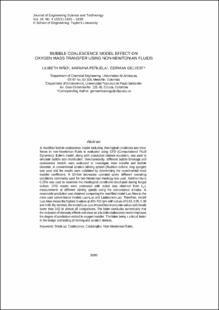Bubble coalescence model effect on oxygen mass transfer using non-newtonian fluids
Artículo de revista
2021-08
Journal of Engineering Science and Technology
Malasia
A modified bubble coalescence model including rheological conditions and shear forces in non-Newtonian fluids is evaluated using CFD (Computational Fluid Dynamics). Euler's model, along with population balance equations, was used to simulate bubble size distribution. Simultaneously, different bubble breakage and coalescence models were evaluated to investigate mass transfer and bubble diameter. A conventional aeration stirring system (Rushton turbine, ring sparger) was used and the results were validated by determining the experimental mass transfer coefficient. A 10-liter bioreactor operated under different operating conditions commonly used for non-Newtonian rheology was used. Xanthan Gum 0.25% was used to resemble the rheological conditions developed during fungal culture. CFD results were contrasted with tested data obtained from 𝑘�𝑘�𝐿�𝐿�𝑎�𝑎� measurements at different stirring speeds using the concordance d-index. A reasonable prediction was obtained comparing the modified model Luo-New to the most used conventional models Luo-Luo and Laakkonen-Luo. Therefore, model Luo-New shows the highest d values at 400-700 rpm with values of 0.83, 0.95, 0.98 and 0.69. By contrast, the model Luo-Luo showed less inaccurate values with levels lower than 0.62 in almost all comparisons. The latter concludes numerically that the inclusion of viscosity effects and shear on a bubble coalescence model improves the degree of prediction related to oxygen transfer. The latter being a critical factor in the design and testing of stirring and aeration devices.
- Ambiente y Vida - GIAV [131]



 PDF
PDF
 LEER EN FLIP
LEER EN FLIP













